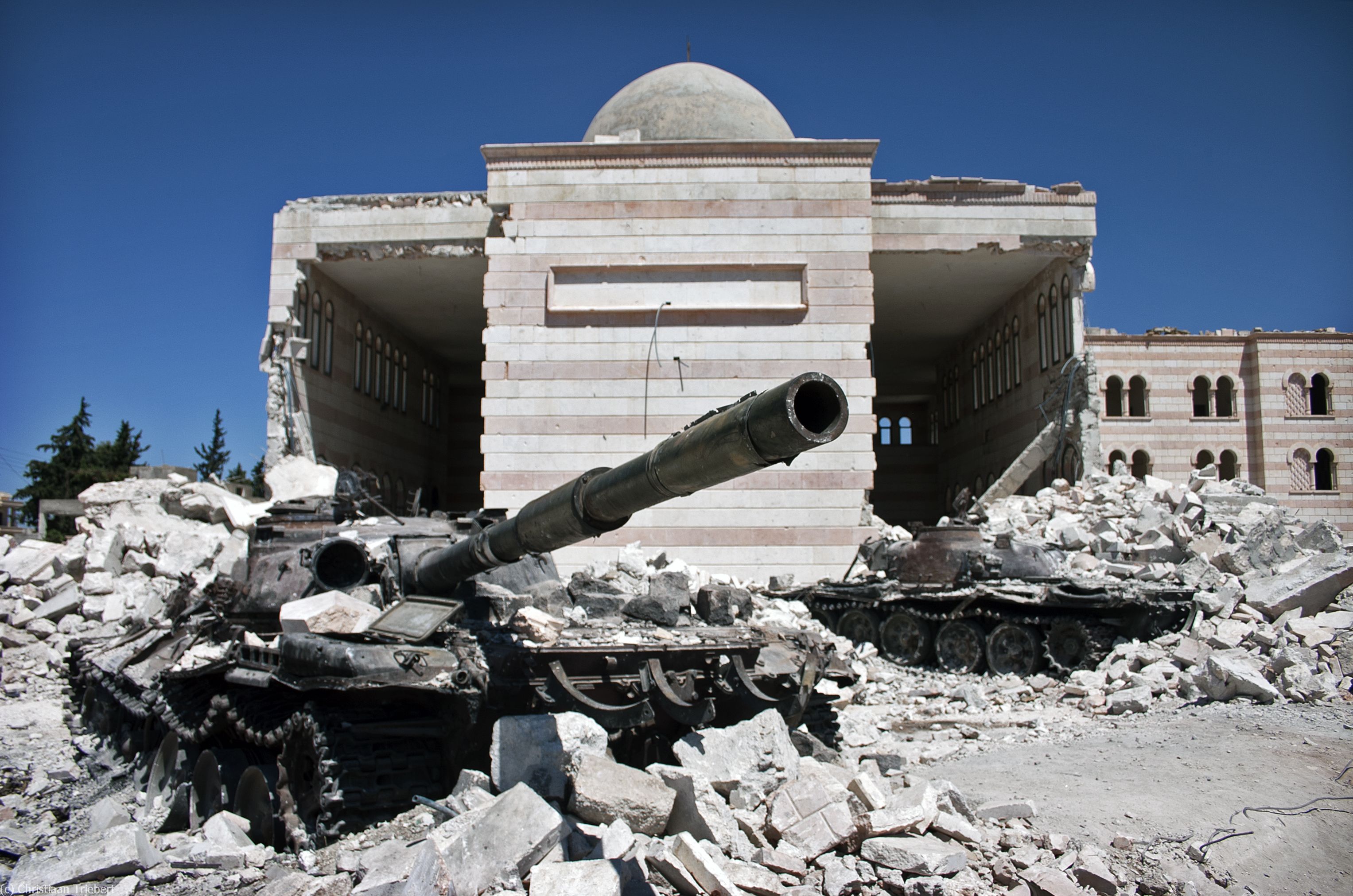By Cole Mullis
One of the primary causes of the Syrian Civil War could also prove to be a great obstacle to lasting peace at its conclusion: the situation of the Alawite religious minority. Embattled Syrian President Bashar al-Assad is an Alawite, along with much of the elite, but the majority of Alawites live in no better conditions than the average Syrian. However, this does not change the fact that many Syrians see Alawites as foreign occupiers due to their influence in government. The future of Syria and its prospects for success as a modern state will largely be determined by how it handles the Alawite situation.
Bashar al-Assad, like his father before him, is an Alawite ruler of Syria. Many of Syria’s elites are Alawites, particularly in the army. This has created deep resentment within the Sunni majority of the country. The Sunni perception of Alawite dominance was a primary cause of protest and ultimately a rebellion in 2011, when the Syrian Civil War began. All parties involved in negotiating Syria’s future must ponder what fate the Alawites will have in a country in which they are the object of widespread hatred.
History of Contention
The Alawites are a heterodox Shia sect that has faced persecution by the Sunni Muslims who form the majority of Syria. The religion emerged a few centuries after Muhammad’s death, but followers of the religion were quickly exiled to the outskirts of the Islamic world, the contested coastal mountains of northern Syria. Leon Goldsmith in his book “Cycle of Fear: Syria’s Alawites in War and Peace” details the the Alawites’ development and treatment in Syria. Caught between Muslim dynasties to the south and the Byzantine Empire to the north, they adapted by assimilating into both their Muslim and Christian neighbors to avoid standing out (Goldsmith 14-24). Nevertheless, they continued to emphasize their distinctiveness from the orthodox Muslim world, and developed and maintained a strong in-group solidarity (22-30).
The Sunni Perspective
Almost as soon as the sect emerged, it was denounced by Muslim clerics (31-37). The most damaging condemnation was the fatwa of the fourteenth century scholar Ibn Taymiyya, who declared them to be “more heretical than the Jews and the Christians, even more so than many polytheists.” Those in power believed the Alawites to be a greater threat to Islam than the Crusaders or Mongols, and that they should should be slaughtered unless they recant. Owing to this, Alawites were harshly treated by the Sunni and only received relatively hospitable treatment by non-Sunni powers such as Shia dynasties, Crusader states, the Mongols, or the French.
Why do Sunnis feel this way? The Alawites emerged as a heterodox sect at a time when the Muslim world was seeking unification. From an orthodox Muslim perspective, their views truly are heretical: Alawite worship of Muhammad’s son-in-law Ali is antithetical to Islam’s strict monotheism, and they do no follow the five pillars (15). They are seen as a fifth column who consistently aid the enemies of Islam, such as the Crusaders, the Mongols, and the French imperialists. It is not uncommon for Alawites in Sunni territory to engage in taqiyya, hiding one’s beliefs for protection, and engage in Sunni practice and proclaim Sunni doctrine while rejecting it at heart (15-16). Adding to this, Bashar al-Assad encouraged Alawites to assimilate and “behave like regular Muslims.” And both Hafez and Bashar have promoted their family members, friends, and fellow Alawites to positions of prominence, which sparks fears that they are advancing their sectarian interests at the expense of the majority.
Early Modern History
Alawite separation and isolation from the Muslim world continued under Ottoman rule. Generally, both the Alawites and the Turks were happy to leave each other alone, but the Alawite region was intentionally kept poor, and any attempt to improve their condition was met with violent resistance (37-43). Even so, the Turkish government largely limited its wrath to legal punishment, not righteous fury: the perpetrators of the greatest cruelties were most often the Sunni Arabs who garrisoned the Syrian province (41).
Following World War I and the dissolution of the Ottoman Empire, Syria was placed under French mandate. The French granted them an autonomous region within the Mandate of Syria in Latakia, comprising the coastal territory in between modern-day Lebanon and Turkey. The Alawites came to see the French as guarantors of their rights and safety against a hostile Sunni majority. Comparatively, the colonial period was a good era for the Alawites: they did not prosper, but they were not persecuted.
The French mandate and the Alawite people had a symbiotic relationship. Assuming they were natural warriors due to their mountainous homeland, the mandate governors encouraged Alawites to join the military. Alawite military presence was also seen as a necessary counterbalance to the hostility of the Sunni Syrians to French rule, just as the Alawites saw the French as protectors against Sunni aggression (64). Through the military, Alawites gained some political influence that they had largely lacked in the preceding centuries of their history. The relationship was so beneficial that many Alawite leaders opposed Syrian independence (65).
The Alawite Perspective
The Alawites were fearful of renewed Sunni aggression, but they found refuge in the Ba’ath Party. The Ba’ath Party sought to unify Arabs under a secularist, socialist nationalism. Alawite culture was tolerant, egalitarian, and communalist, so this greatly appealed to them (70-73). Ba’athism was co-founded by an Alawite, and was quickly embraced by the Alawite military officers. Furthermore, the Grand Mufti of Jerusalem issued a fatwa declaring the Alawites to be members of the Muslim community in the interest of pan-Arabism. It appeared that with the novelty of Arab nationalism, the sectarian divides and bad blood could be left in the past.
In 1963, the military placed the Ba’ath Party in power, and in 1973 Sulayman’s son, Hafez al-Assed, emerged as the leader of Syria, and instigated a purge of the Party that largely allowed for Alawites to fill new vacancies (82-84). In 1971, Assad made himself president, and in 1973 authorized a new constitution that removed the requirement that the president be a Sunni. This sparked protests that culminated in a rebellion in 1979 led by the Muslim Brotherhood (93-106). During this uprising, Islamist protestors were known to chant “Christians to Beirut, Alawites to the grave.” Sectarianism, repressed by the French and Ba’athists, had returned, with potentially catastrophic repercussions for the Alawites.
The rebellion was violently repressed by Hafez al-Assad, but the anti-Alawite and anti-secular sentiments rumbled under the surface and boiled up once again at the outbreak of today’s Syrian civil war when the genocidal chant was heard once more. There have been numerous instances of rebel violence against Alawites. A rebel leader claimed that if the Alawites did not abandon the regime, “Syria will become the graveyard of the Alawites.” A representative of the Free Syrian Army claimed that a genocide of Alawites would be an unfortunate reality should the government persist in its crimes.
Alawite opposition to the rebellion is exacerbated by the Free Syrian Army’s close ties with the Islamist Fateh al-Sham (formerly Jabhat al-Nusra), the largest rebel military, which seeks to convert the Alawites, as well as Druze and Yazidis, by force. Also, many may think that the Assad regime is better suited to combatting the Islamic State, who, unlike Fateh al-Sham, does not believe in conversion, and will slaughter the Alawites mercilessly should they conquer Latakia.
From this, we can understand the profound mistrust and fear that the Alawites have of the Sunnis, and, consequently, any democratic future for Syria.
To Alawites, democracy is the vehicle of Salafism, and the current rebellion is no different than the 1979 Islamist Uprising that had specifically targeted Alawites. The regime, whatever its crimes, protects minority rights and grants them something of a voice. In a majoritarian democracy, their voices would be drowned out by a vindictive majority seething from decades of perceived relative deprivation.
Potential Resolutions
The Alawites clearly have a troubled history and a precarious situation. As it stands, there are four likely futures for the Alawite people: separation, protected pluralism, assimilation, or destruction.
The Alawites could return to their political situation circa 1920, with a state independent of the rest of Syria. Geopolitics could very well make this a reality, as an independent “Alawistan” could have Russian and Western support.
Due to its size it would likely be a client state but energy could grant a degree of autarky. While most of Syria’s oil lies along the Euphrates (territory currently controlled by ISIS), there are significant oil and natural gas deposits on the coast, with much of it unexplored. However, this also could be a cause of conflict: Syrian Sunnis are unlikely to willingly part with such valuable resources.
It is also necessary to mention the large numbers of Sunnis within the Alawite region. The southern region of a potential Alawistan, the Tartus Governorate, is solidly Alawite, and the city is 80 percent Alawite. However, in the north it’s more complicated. Only fifty percent of the Latakia Governorate is Alawite, thirty percent are Sunni, and twenty percent are Christian. The city of Latakia, the primary port of Syria, is majority Sunni.
The Alawite regions have largely avoided the fighting, but there has been some conflict with the Sunni population that resulted in tragedy. It is unlikely the Sunni minority, even those that supported the regime, would voluntarily submit to Alawite control.
Alternatively, Syria could remain whole, but grant a degree of autonomy and guaranteed rights to minorities such as the Alawites. Considering the great deal of sectarian hostility in Syria, any pluralistic solution would have to be guaranteed by outside powers.
The Alawites today are no more optimistic about the Sunnis’ intentions than they were in 1936. Again, this is not entirely paranoia, as the vast majority of Syrians support retaliatory genocide against Alawites, potentially up to 96 percent. If the Sunni rebels take control, they might be merciful and only demand assimilation rather than subjugation or extermination.
This would largely mean that the Alawites abandon the cultural practices that set them apart: they would stop drinking, and women would wear headscarves. It would also mean that many would convert, under threat of force or voluntarily, in order to escape persecution. This wouldn’t be the first time the Alawites lived under Sunni domination. Their practice of taqiyya allowed their religion to persist underground, while on the surface they behaved as orthodox Muslims. It could be that they hold on to their religion by keeping it clandestine and subtle, and that persecution grants them greater in-group solidarity and ethnic consciousness, as it has historically. But it is more likely that they would acquiesce under the threat of annihilation, and a unique religion and culture would become history.
Citations in this article are from the following book: Goldsmith, Leon T. Cycle of Fear: Syria’s Alawites in War and Peace. London: Hurst, 2015.

